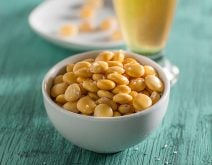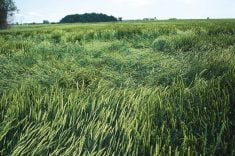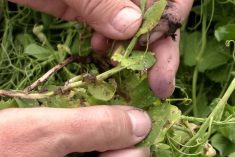Shaun Dyrland says even in a dry growing season, if there is a thunderstorm that drops about an inch of rain some of the lentil fields on his west-central Saskatchewan farm will be dead within a matter of days. That’s just an indication of the effect root rot disease — particularly aphanomyces — can have on the most profitable crop on his farm.
Dyrland, who crops about 16,000 acres of pulses, grains and oilseeds southwest of Kyle, says many farmers are caught between a rock and a hard place when it comes to growing pulse crops. Obviously, rain is needed to help crops grow, but it doesn’t take a great deal of moisture to trigger an outbreak of the soil-borne disease, which can quickly reduce or wipe out yield in lentil and pea crops.
“It is just a devastating situation for ourselves and many other farmers,” says Dyrland. “Lentils have been the most profitable, best-returning crop on our farm, but now aphanomyces is forcing us to reduce acres, extend rotations as best we can and look at alternative crops.
Read Also

Cancer agency reclassifies another herbicide ‘probably carcinogenic’
The WHO’s cancer research agency has now put atrazine, a herbicide well known to corn growers, in the same potential-hazard category where the agency put glyphosate.
“We manage it the best we can, but I really don’t see any solution until we get varieties with genetic resistance to the disease and/or seed treatments that are also effective against the pathogen.”
And until some type of a silver bullet (if it even exists) is developed, Agriculture and Agri-Food Canada researcher and plant pathologist Syama Chatterton says the best approach is, first, to manage rotations to hopefully prevent the disease from appearing on your farm and if it is already present to apply management practices that reduce the effects of the disease. There is no quick fix — it’s about making the best of a complicated situation.

Cropping rotation near Kyle
Dyrland, who farms with family members, crops a total of 16,000 acres including about 2,000 acres under irrigation and 14,000 acres of dryland. Crop rotation includes pulse crops on about 50 per cent of their dryland acres — large green and red lentils, yellow peas and, more recently, Kabuli chickpeas. The rest of the farm is seeded to canola, durum and barley.
Dyrland says it was about 25 years after growing the first pulse crops — Laird lentils in the late 1990s — that serious disease issues showed up on the farm. Aphanomyces wasn’t identified until the 2016 growing season, and then it hit with a vengeance.

“According to local weather records, we had about 40 inches of rain that year,” says Dyrland. “Everything was saturated, crops were lost, but we learned the underlying issue with the pulse crops was aphanomyces.
“Up until then, there might be a low spot on the field where the crop died out, but we figured it was just too much moisture. We’ve come to realize probably that was a patch of field infected with aphanomyces and now it has spread.”
Dyrland, who is also the chair of Saskatchewan Pulse Growers, says on his farm the lentils appear to be more susceptible to the disease — yield can be wiped out — whereas yellow peas are not as seriously affected.
To manage the disease risk, Dyrland says he extends the rotation between susceptible pulse crops as much as possible and for the past four years that has involved bringing Kabuli chickpeas into the rotation. They grow reasonably well in his area and chickpeas show resistance to aphanomyces.
Faba beans and soybeans are also pulse/legume crops less susceptible to root rot disease, but because they are later maturing, they really don’t have a fit in Dyrland’s rotation.
Dyrland says the persistence of the pathogen that causes root rot disease, Aphanomyces euteiches, poses a particular challenge. The recommendations are to extend rotations between pulse crops by four, six or, even, eight years. “Yet we have some fields where we haven’t grown a pulse crop for 10 to 15 years and when we did plant peas or lentils, the disease was still active,” he says. “It is extremely long lived.”
As of early April, Dyrland shakes his head thinking about cropping decisions for the 2022 season — they may not be made until the last minute. It has been a low snowfall (dry) winter in his area and he didn’t expect to be in the field until the soil warms up in early May.

“We have a few things to consider,” he says. “The 2021 growing season was a major drought in this area and we are still dry. Soil testing shows we have high residual fertility in the soil. The tests are also showing, in some fields, we have a high risk of Group 2 herbicide carryover (there just wasn’t enough moisture to dissipate chemical in the soil profile). And then there is also the risk of what happens if we do get moisture, which could mean a serious outbreak of aphanomyces.
“We have a pretty good idea of what we’d like to do this year, but there are a lot of variables to affect cropping decisions. It will probably come down to what the conditions are like as we are about to head out to the field.”
And on the research front
Chatterton, who is based at the Lethbridge Research and Development Centre, says trying to manage pulse crop root rots — aphanomyces in particular — is a complex business.
These naturally occurring pathogens are like a nightmare visitor who arrives at your doorstep and never wants to leave.
There are several pathogens that fall into the category of root rot diseases, which include Pythium spp., Botrytis spp., Fusarium spp. and Rhizoctonia solani. All of these pathogens can be damaging to pea and lentil yields in varying degrees of severity. However, all can be controlled to some extent with seed treatments and all seem to have a more limited resting spore lifespan than the aphanomyces-causing pathogen, A. euteiches.

“Aphanomyces euteiches is the most damaging to peas and lentils of all the root rots. There is no effective control, and we really have no good handle on how long it will persist in the soil,” says Chatterton. “Some of the older literature and recommendations say it can persist for 10 to 20 years. More current recommendations are to extend rotation to six to eight years between susceptible crops, but even that doesn’t work in every situation. I think it really comes down to the soil type and the moisture regime in any given area.”
Chatterton says with 2021 being a very dry year in many parts of Western Canada, root rot severity was relatively low, “but that doesn’t mean that farmers should be complacent,” she says. “It is still out there. So don’t use 2021 as an indicator. Think back to the last time you grew peas or lentils in a more normal or higher-moisture growing season — how did your crops perform?”
If pulse crops are infected with root rot disease, she says it is important to determine which pathogen it is. She recommends having the soil or, better yet, root samples tested to determine which pathogen is present. None of the diseases are great, but crop rotation and seed treatments might be more effective if you’re only dealing with Fusarium spp., for example. A different management approach might be required if the pathogen is A. euteiches.
“My recommendation is, during the growing season, send samples of infected roots to a lab for proper testing,” she says. “That’s more certain than testing a soil sample. Then a farmer knows for sure what they are dealing with.”

Chatterton’s research looks at root rot from a couple of different perspectives. First, what is the proper rotation interval between susceptible pulse crops if you don’t have aphanomyces on the farm? Also, what is an appropriate interval if the disease pathogen is already there? In another research project she is looking at some other cultural practices, which might help to reduce the effects of the disease.
In terms of rotation and cropping intervals, Chatterton says if there is no aphanomyces in a field or on the farm, aim for at least a one-in-four-year rotation between pulse crops. “The longer the interval between susceptible pulse crops, the lower the risk of the disease developing on your farm,” she says.
If root rot pathogens are present on the farm, a longer interval of perhaps six to eight years between susceptible pulse crops is recommended, but again there is no guarantee. She says a lot will depend on the soil type and moisture regime.
A look at cultural practices
Research involving cultural practices hasn’t arrived at any firm conclusions, but it’s showing some promise at helping reduce the effects of the disease.
One area of research is looking at the use of certain preceding crops to reduce the effects of root rot the following year. Crops such as mustard, oats and even faba beans are known to produce biofumigants, meaning they release chemical compounds that naturally control root rot pathogens.
“The idea is to seed one of these crops on a field, then plow it under as green manure and the following season seed peas or lentils on that field,” says Chatterton. “Chemicals released in the green manure may help control the severity of the root rot.”

Preliminary findings in research trials at Lacombe, in the black soil zone, show faba beans and oats used as green manure appeared to benefit pea yields the following year. However, there was no apparent benefit when the trial was carried out on plots within the brown and dark brown soil zones.
To Chatterton, that suggests the effect is biomass dependent. In the black soil zone, there was more green manure biomass plowed into the soil producing a greater chemical effect on the pathogen, compared with, perhaps, a lighter or thinner green manure crop in the drier growing areas.
Non-host crops
In one other area of research, Chatterton is using root rot-resistant or non-host pulse crops in rotation with susceptible pulse crops to see if the non-host crops can be used to reduce the rotation interval for susceptible pulse crops.
Pulse crops such as faba beans, chickpeas and soybeans are resistant or even considered as non-host pulse crops when it comes to aphanomyces. Could these crops be used in rotation with peas, for example, to help reduce disease levels and the pea crop interval — grow peas one year then plant a resistant pulse crop for one or more years following?
“We looked at growing these non-host pulse crops in a rotation with two-, three-, four- and five-year intervals between pea crops and, basically, we found you’re going to have to wait a long time before you see an effect,” says Chatterton.
“And it may depend on where you farm,” she adds. “At Taber (east of Lethbridge), the resistant crops were grown as part of an eight-year rotation cycle between pea crops and there was still no reduction in disease level. However, at Redvers, in southeastern Saskatchewan, there appeared to be some benefit after four years. So, there was no conclusive recommendation. It may depend on the soil type and moisture regime.”
Chatterton says even though there is no effective registered seed treatment for aphanomyces, she recommends using the products on all pulse crop seeds, just to help the seedlings get off to a good start. One of the issues with A. euteiches is it can infect the pulse crop at any time, not just at the seedling stage.
For more information on dealing with pulse crop diseases, the provincial pulse growers’ associations along with the University of Saskatchewan have produced an excellent fact sheet called, Root Rot in Peas and Lentils in Western Canada (opens as a PDF). It is available online.
















